

Enhance: Stories of Excellence in Education Is it time to take a fresh look at MOOCs? The COVID-19 pandemic has placed a sharp focus on online learning, so where do Massive Open Online Courses – MOOCs – fit into the picture?
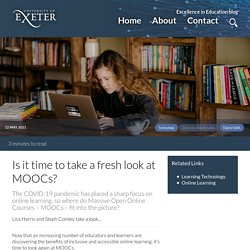
Lisa Harris and Steph Comley take a look… Now that an increasing number of educators and learners are discovering the benefits of inclusive and accessible online learning, it’s time to look again at MOOCs. The University of Exeter has been working with social learning platform FutureLearn since 2013. We were one of the initial 10 partners, launching Climate Change: Challenges and Solutions with 16,221 learner registrations in 2014. Since then we have launched 22 FutureLearn courses which have attracted more than 117,000 active learners. Our MOOCs are fully online, available to a global audience, free to join and cover a wide range of subjects. Recently the FutureLearn course model allowed us to make a quick response to help fill the knowledge gap relating to COVID-19 in Nursing practices. Sharing Resources through FutureLearn Campus Useful Resources.
The colleges and universities with the most online students in 2018. The Education Department's annual release of data about postsecondary enrollments is a font of information -- and we've already mined it for an article about the continuing (but slowing) rise in online enrollments in 2018.
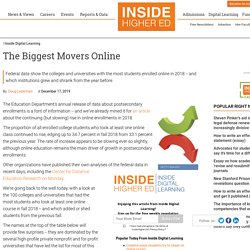
The proportion of all enrolled college students who took at least one online class continued to rise, edging up to 34.7 percent in fall 2018 from 33.1 percent the previous year. The rate of increase appears to be slowing ever so slightly, although online education remains the main driver of growth in postsecondary enrollments. Story continued below… Enjoying this article from Inside Digital Learning? Sign up for the free weekly newsletter. I have read and agree to the terms ofInside Higher Ed’s Privacy Policy Other organizations have published their own analyses of the federal data in recent days, including the Center for Distance Education Research on Monday.
The DIP-approach: student-staff partnerships as a vital tool for learning developers and educators to develop academic [and digital] literacies. MOOCs Are No Longer Massive. And They Serve Different Audiences Than First Imagined. MOOCs have gone from a buzzword to a punchline, especially among professors who were skeptical of these “massive open online courses” in the first place.
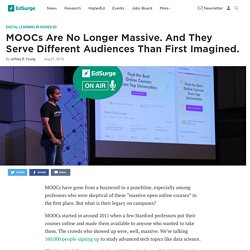
But what is their legacy on campuses? MOOCs started in around 2011 when a few Stanford professors put their courses online and made them available to anyone who wanted to take them. The crowds who showed up were, well, massive. We’re talking 160,000 people signing up to study advanced tech topics like data science. The New York Times later declared 2012 as the ‘year of the MOOC,’ and columnists said the virtual courses would bring a revolution. The GoodPractice Podcast: 127 — How do I design MOOCs that people actually complete? Flexible learning: the current state of play in UK higher education. Coursera's Monetization Journey: From 0 to $100+ Million in Revenue — Class Central. In April, Coursera announced a major Series E funding round of $103 million, their largest yet.

With this raise, Coursera has entered Unicorn territory (over $1 billion in valuation), with $313.1 million raised. As you may recall, MOOCs were born without a business model. In the beginning, everyone wondered how free courses would ever make money. Last year Coursera reportedly made around $140 million dollars. Through Class Central, I have been tracking and writing about the evolution of the MOOC space right from the beginning. This article is based on the keynote that I gave last year at The 9th TCU International e-Learning Conference 2018 in Thailand, titled A Product at Every Price: Overview of MOOC Monetization Models.
George Siemens sur Twitter : "8000 people completed the certificate (~1 year old). This lifelong learning/reskilling/upskilling need is significant. It's the future revenue model universities need to offset demographic/international decline. But we're not. Expected growth of online HE at the @FutureLearn Partners' Forum from Maria Spies of @holoniq #FLForum… AI tutors will make mass retraining a viable reality. It is commonly agreed that automation will take over large numbers of existing jobs over the next generation, requiring humans to train and retrain for new but different roles.
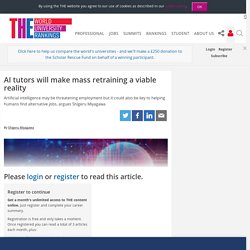
We can already see this happening. College graduation rates are increasing across all Organisation for Economic Cooperation and Development (OECD) countries, and one-third of this increase is accounted for by adults aged between 25 and 34, who are already likely to be working. Many will be taking online courses; even in a country such as Japan, in which the college-age population is declining, enrolment is expanding on the few fully online programmes available. Philosophical (Not Financial) Drivers of Online Education. Article in Journal ‘Science’ Argues MOOC Participation is Declining as Providers Pivot. What lessons can be learned from the rise and pivot of massive open online courses (MOOCs), those large-scale online courses that proponents said would disrupt higher education?

An article this week in the prestigious journal ‘Science’ explores that question, digging into six years of data from MOOCs offered by Harvard University and MIT on the edX platform launched by the two universities. At the start of the MOOC trend in 2012, the promise was that the free online courses could reach students who could not afford or get access to other forms of higher education. The reality, the article points out, is quite different: “The vast majority of MOOC learners never return after their first year, the growth in MOOC participation has been concentrated almost entirely in the world’s most affluent countries, and the bane of MOOCs—low completion rates—has not improved over 6 years.”
In fact, completion rates for MOOCs in the study declined. Coursera Announces Two MOOC-Based Degrees from the University of Colorado Boulder. Coursera, the leading MOOC platform, announced during its 2019 Partners Conference in London the launch of two more online degrees, both from the University of Colorado Boulder: a Master of Science in Electrical Engineering (MS-EE) and a Master of Science in Data Science (MS-DS).
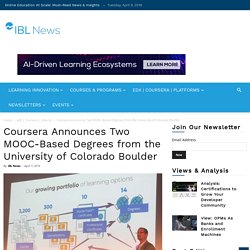
This brings the total number of degrees announced on Coursera’s platform to 14. Admission to both degrees will be performance-based, and there will be no prerequisites or an application. Students will need to pass a series of courses and obtain stackable credentials. The pathway to enrollment for the MS-EE is expected to open in 2019. Moocs struggle to lift rock-bottom completion rates. Much of the early enthusiasm for massive open online courses, or Moocs, focused on how they could disrupt and democratise education — opening elite universities’ courses to the masses.
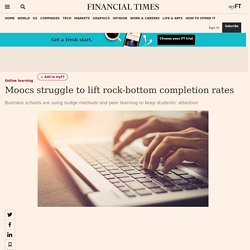
They have long faced one stumbling block, however: barely anyone who starts a Mooc completes it. A recent study by academics at the Massachusetts Institute of Technology found that online courses had an astronomical dropout rate of about 96 per cent on average over five years. Instructional quality of Massive Open Online Courses (MOOCs) Leaders & Legends of Online Learning – Dedicated to the experts. Michelle Smyth sur Twitter : "MOOCs, if designed inclusively, have the potential and ability to create reciprocal channels between truly diverse global participants, where a plurality of voices can be heard and true diversity of global knowledge can be ac. Digital transformation in education: The FutureLearn view. In this piece, Nigel Smith of The Open University-owned FutureLearn, reflects on the digital transformation in education over the past six years since MOOCs (massive open online courses) first burst onto the scene There is no choice but to innovate in scaling the supply of education.
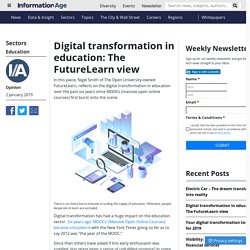
Otherwise, people desperate to learn are excluded. Digital transformation has had a huge impact on the education sector. Six years ago ‘MOOCs’ (Massive Open Online Courses) became a buzzword with the New York Times going so far as to say 2012 was “the year of the MOOC.” Since then others have asked if this early enthusiasm was justified. FutureLearn counts a quarter of the world’s top 200 universities among its partners and what these partners continually reiterate is that the key value of MOOCs has been as a catalyst for wider digital transformation. On a more macro level, tertiary education enrolment rates globally are expected to rise rapidly by 14 million new students every year from now until 2030.
Coursera CEO Interview: Betting on OPM market and shift to low-cost masters degrees - Open Education Resources, Massive Open Online Courses, and Online Platforms for Distance and Flexible Learning – Jon Dron's home page. Ironically published in a closed and massively over-priced Handbook of IT in Primary and Secondary Education, here’s a chapter from me and Gerald Ardito on open and distance learning in the context of teaching children (paywall).
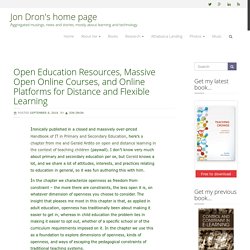
I don’t know very much about primary and secondary education per se, but Gerald knows a lot, and we share a lot of attitudes, interests, and practices relating to education in general, so it was fun authoring this with him. In the chapter we characterize openness as freedom from constraint – the more there are constraints, the less open it is, on whatever dimension of openness you choose to consider. The insight that pleases me most in this chapter is that, as applied in adult education, openness has traditionally been about making it easier to get in, whereas in child education the problem lies in making it easier to opt out, whether of a specific school or of the curriculum requirements imposed on it.
The Metamorphosis of MOOCs. At a recent meeting of educational technology policy advisors, a well-informed university CIO casually declared that MOOCs were history. It’s true they stopped making headlines a while ago, but they have hardly abated. They may, however, need a change of name, just as we rename mature caterpillars “butterflies” or “moths.” Increasingly, MOOCs are being packaged into series of courses with a non-degree credential being offered to those who successfully complete the series. Moocs-2016. Moocs-2016. Reconceptualising Learning in the Digital Age - The [Un]democratising Potential of MOOCs. Sign IN - Open University. The MOOC is not dead, but maybe it should be. Five years after the New York Times anointed 2012 as the Year of the Massive Open Online Course (MOOC), Udacity – the company founded by Sebastian Thrun, the self-described forefather of MOOCs – pronounced them dead.
This was met with no small resistance from staff and institutions continuing to produce MOOC content and courses. Is the MOOC, as Udacity says, a failed product – or have we not, as Arshad Ahmad and Barbara Oakley contest, given the product a true chance? Within formal higher education, Udacity has long been criticied for their propulsion of (and profit from) the MOOC hype machine, securing government contracts in the United States to “fix” higher education, only to pivot away from the sector less than one year later. If MOOCs are not dead, what are they doing? Joksimovic et al. 2017 How Do We Model Learning at Scale A Systematic Re (preprint) Trends and Patterns in Massive Open Online Courses: Review and Content Analysis of Research on MOOCs (2008-2015) Trends and Patterns in Massive Open Online Courses: Review and Content Analysis of Research on MOOCs (2008-2015) Aras Bozkurt, Ela Akgün-Özbek, Olaf Zawacki-Richter Abstract. Moocs can still bring higher education to those who really need it.
In the world of digital education, massive open online courses (Moocs) are here to stay. It may have been five years since The New York Times declared 2012 to be the Year of the MOOC, but Moocs are still multiplying and branching out into new forms of accredited learning experiences. All the major Mooc platforms – such as edX, Coursera, Udacity and FutureLearn – are offering some kind of professional certification or degree-level study.
You can study a business-skills focused MicroMasters with edX or a Nanodegree with Udacity or take a full master’s online with FutureLearn or Coursera. The platforms themselves have improved, adding new features that have shifted learning away from the transmission mode of video lectures to embrace more meaningful peer-to-peer learning opportunities, feedback and practice. While thousands of learners have found that the scaled-up learning model works for them, only a small, privileged section of the global population currently use Moocs. Whatever happened to the promise of online learning? Online learning always talks big. Some combination of enrolment growth, enhanced teaching and learning, wider access and lower costs has been promised in the name of online learning over the last 20+ years.
These promises have often been phrased in terms of new market entrants and disruption to conventional institutions. There is no question that digital technologies are increasingly mainstream in UK universities and universities around the world, and there are many dedicated online institutions, but twenty years on online learning might be better described as supplementary. Supporting new learners in open education. Last week I attended a conference at the Karolinska Institute in Stockholm called MOOCs in Scandinavia which was an opportunity to take stock of the development so far and hopefully create a springboard to future development. Proceedings emoocs2016. How learners’ interactions sustain engagement: a MOOC case study - IEEE Journals & Magazine. Social Learning and large scale online learning.
Who Does What in a Massive Open Online Course? By Daniel T. Seaton, Yoav Bergner, Isaac Chuang, Piotr Mitros, David E. Proceedings emoocs2016. Design Patterns for Open Online Teaching and Learning Design Paper 42 7. Proceedings emoocs2016. Retention and Intention in Massive Open Online Courses: In Depth. Retention in MOOCs should be considered in the context of learner intent, especially given the varied backgrounds and motivations of students who choose to enroll. When viewed in the appropriate context, the apparently low retention in MOOCs is often reasonable. The MOOC "Retention Problem" In 2012, the typical Coursera massive open online course (MOOC) enrolled between 40,000 and 60,000 students, of whom 50 to 60 percent returned for the first lecture. TopMOOC Final Paper. How video production affects student engagement. In depth 33 4 0. Mooc report 2013. Proceedings emoocs2016. Pedagogical roles for video in online learning.
This video is taken from OpenLearn's free Maths unit ` Modelling with first order differential equations `. The full unit is available for free at. Learning Creative Learning: It’s not a MOOC, it’s a community. MOOCs Are "Dead." What's Next? Uh-oh. Are MOOCs deepening divisions in higher education? Technology is often described in the literature as an enabler, a facilitator, a supporter, as an enhancer and as empowering, but for millions around the world, this is not always the case. Pursuit by The University of Melbourne. Why do some of us learn easily and quickly, while others struggle, left behind plodding along? Part of the answer, at least in the online learning space, is that learning is a real skill in of itself, and some people are more skilled at it than others.
And the good news for the plodders is that it is a skill that can be readily grasped when we break it down. Moocs-2017-on-campus-and-off (GIF Image) Sign IN - Open University. Why Study on a MOOC? The Motives of Students and Professionals. Why Study on a MOOC? The Motives of Students and Professionals Colin Milligan, Allison Littlejohn. Open Education Europa. Design Patterns for Open Online Teaching and Learning. The Development of Learner Self-Efficacy in MOOCs - Learning & Technology Library (LearnTechLib) Google Image Result for. Course: How to make an open online course - onlinecourse_1.0. The secret life of face-to-face learning in MOOCs (Part 1) MOOCs: The Beginning of the End? Redefining Open: MOOCs and Online Courseware in...
The Advancing MOOCs for Development Initiative: An examination of MOOC usage for professional workforce development outcomes in Colombia, the Philippines, & South Africa. Journal of Computer Assisted Learning - Volume 32, Issue 3 - Learning Analytics in Massively Multi-User Virtual Environments and Courses. State of the MOOC 2016: A Year of Massive Landscape Change For Massive Open Online Courses. Classifying the Irish 101 LMOOC.
10 ways MOOCs have forced Universities into a rethink (demand, assess, accred, tech, cost) Miri Barak. Mark Smithers' Personal Blog. Yuan et al 2014. MOOCs: Here to stay - panel session at Online Educa Berlin 2015. Studying a MOOC Neil Morris James Lambe. MOOCs and Quality: A Review of the Recent Literature. Funding for Chinese Online Learning Platforms Increased Tenfold in 2014. Reaching the parts others cannot teach - BBC News. Newsletter: Open Professional Collaboration for Innovation. Leading Issues in e-Learning Research MOOCs and Flip Whats Really Changing Volume 2 PRINT ISBN 978-310309-89-6. Bonk, C. J., Lee, M. M., Kou, X., Xu, S. & Sheu, F.-R. (2015). Understanding the Self-Directed Online Learning Preferences, Goals, Achievements, & Challenges of MIT OpenCourseWare Subscribers. Ed Tech & Society, 18(2), 349-368. Available:
Jim Harriss from Northampton. Keeping Them Clicking: Promoting Student Engagement in MOOC Design. The Invisible Learners Taking MOOCs. MOOCs, institutional policy and change dynamics in higher education. Personal Inquiry: Science Investigations with Mobile Technology. Making ‘MOOCs’: The construction of a new digital higher education within news media discourse. Cognitive presence and open learning: coming full circle again with #HumanMOOC. UCL E-Learning Environments team blog. MOOCs. HarvardX and MITx: Two Years of Open Online Courses Fall 2012-Summer 2014 by Andrew Dean Ho, Isaac Chuang, Justin Reich, Cody Austun Coleman, Jacob Whitehill, Curtis G Northcutt, Joseph Jay Williams, John D Hansen, Glenn Lopez, Rebecca Petersen.
Learner Experiences with MOOCs and Open Online Learning. Massive Open Online Courses Prove Popular, if Not Lucrative Yet. Research - Projects - Conceptualising interaction and learning in MOOCs. Innovating_Pedagogy_2014.pdf. College of Social Sciences. The MOOC Hype Fades, in 3 Charts. Making massive learning social – the next big challenge for MOOCs? Untitled.